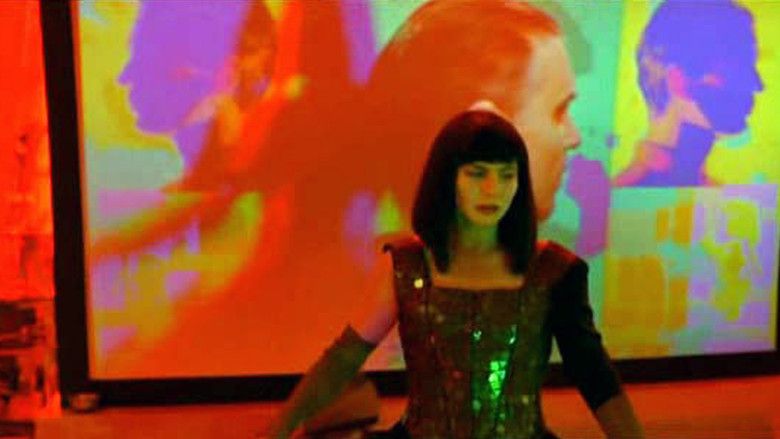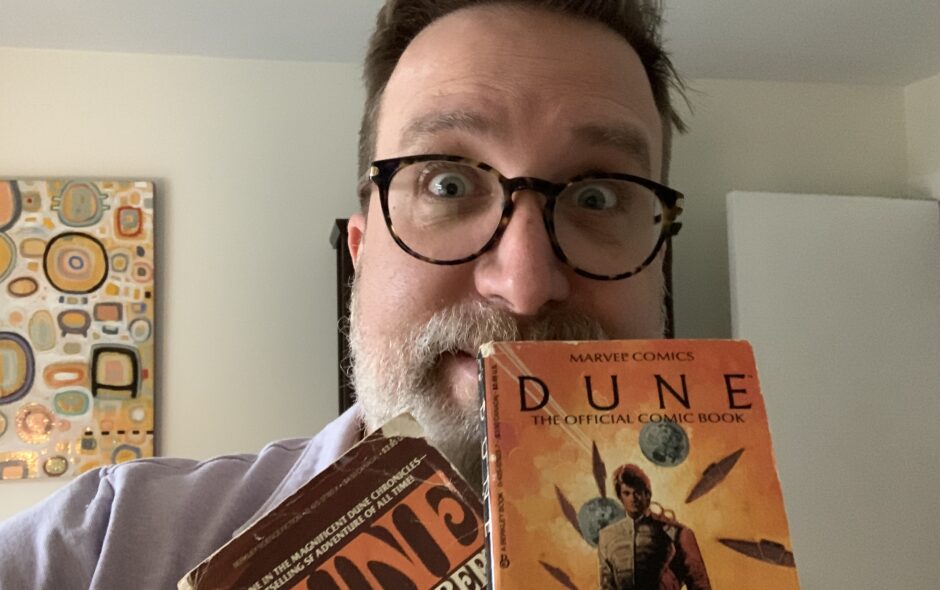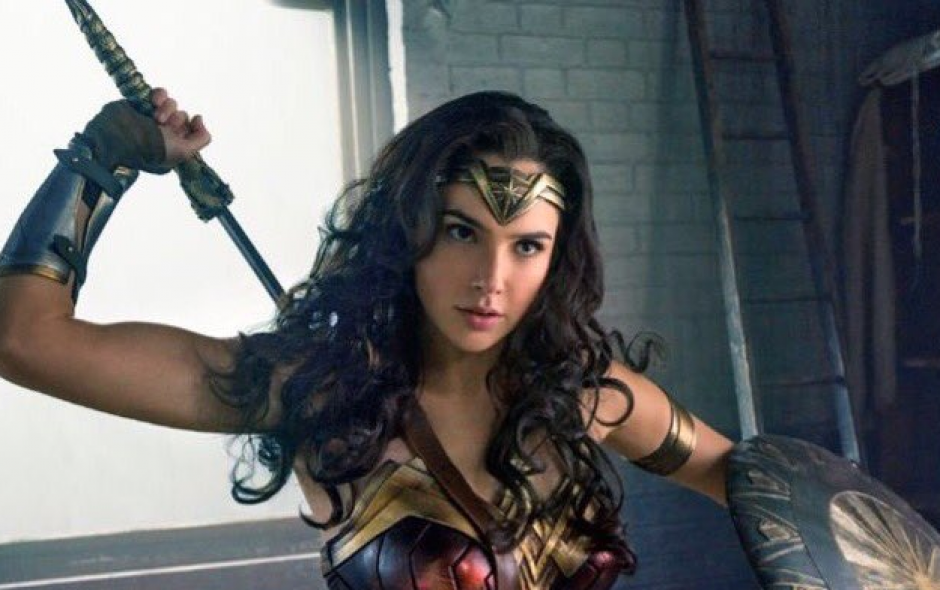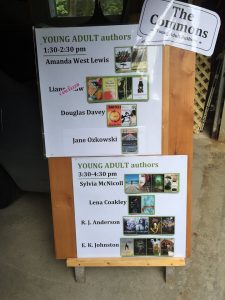I’ll be reading as part of the Brockton Writers’ Series – details here
New Sections Added!
I created this website to promote my writing, but as I am on a hiatus to focus on my library work, I’m also using my site for sharing other things as well. You’ll see two new sections, one for the puzzles and games that I make, and one for movie reviews, check them out!
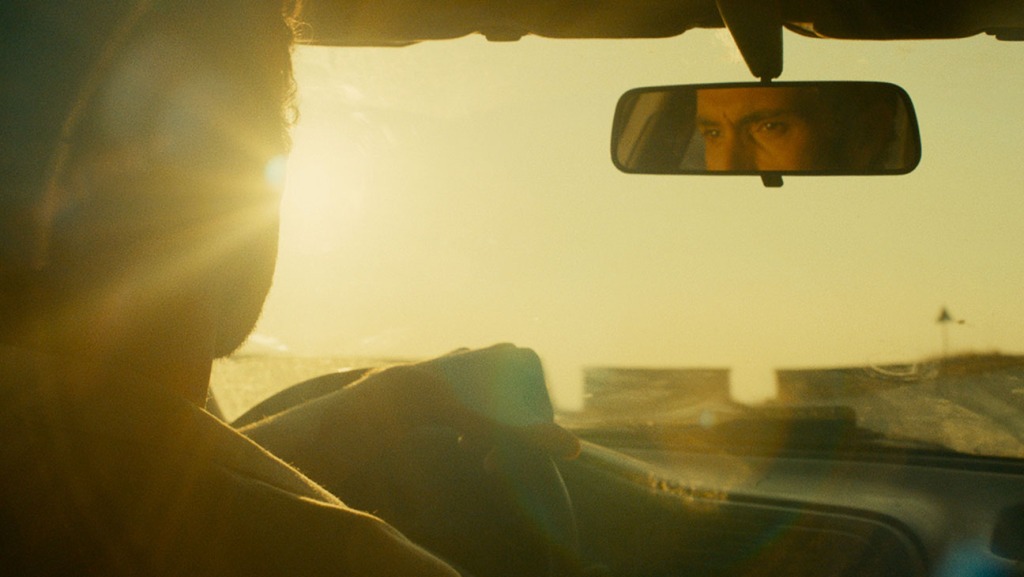
A lengthy response to the long (and ever-longer) lost cause that is “Until The End of the World”
I’m feeling nostalgic. I don’t know why, maybe it’s the holidays, or maybe it’s the thought of my teen heading off to university next year. What I do know is that between the plague that has us all at our wit’s end and the frightening disintegration of our neighbours to the south, the future seems less appealing than the past.
So, nostalgia it is.
I was in my late teens / early twenties at the start of the 1990s, and I find myself reflecting wistfully on this era, on a time when I was freer to follow my whims, on a world without the ambient anxiety field generated by the Internet, and when you could go to a bar in the same clothes that you’d slept in have that be considered “style.” (Side note: ladies, please bring back army boots and cutoff jeans over leggings!)
And so it was in this nostalgic mindset that I decided to dive into the nearly FIVE HOUR director’s cut of Wim Wenders’ 1991 arthouse flop “Until the End of the World.” My situation was a perfect storm: I was on holiday, my spouse was away visiting family, and my Criterion subscription was coming to an end- it was now or never. After having sat through this interminable 4 hour and 45 minute version, I can tell you that the movie, while not without its strengths, is not great, and that adding a few more hours does nothing to correct its shortcomings, quite the opposite in fact. (Note: The director says that the theatrically-released version had “all the fun” taken out of it, which implies that there was some fun to begin with.)
Normally, I write about the things I love, but I feel compelled to record my thoughts about this weird cinematic footnote.
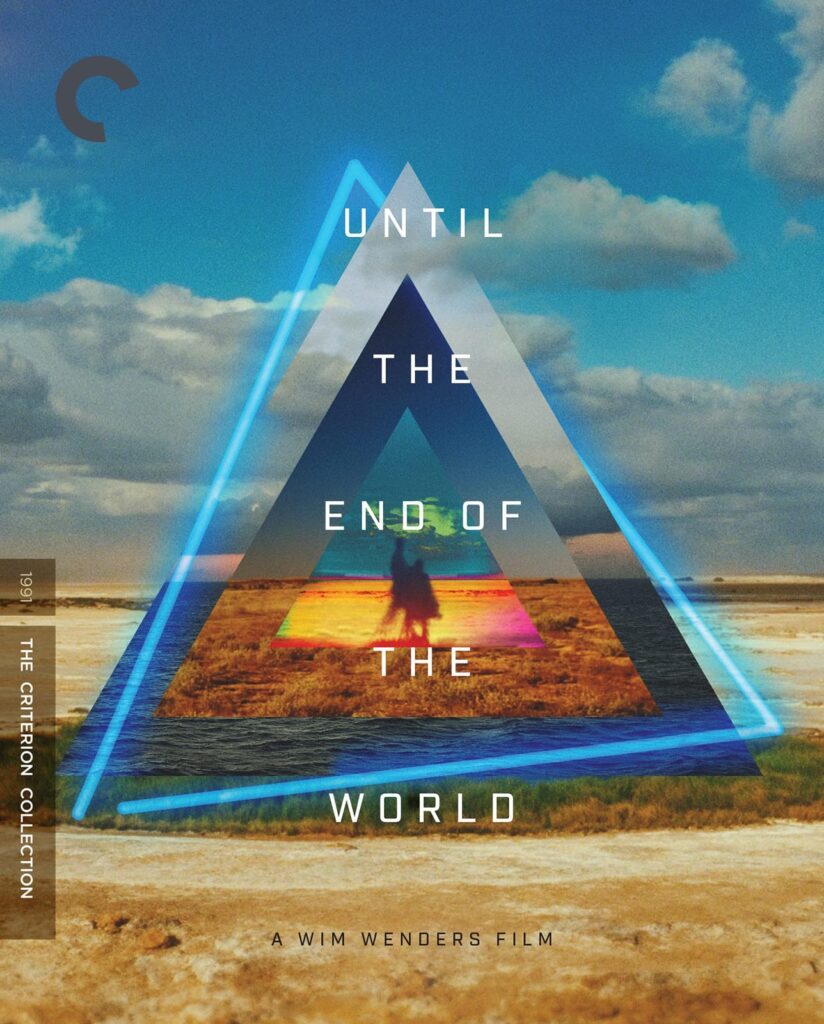
When I watch an overlong movie, I usually say something like, “there’s a good movie in there somewhere, it just needs to be cut down.” Not here. Two friends independently relayed the following anecdote: while seeing the movie at their local rep cinema, the movie has a line towards the finale that goes something like “we thought it was the end, but it was only just beginning” at which point the entire audience groaned.
While I wasn’t among those who saw it upon release, I do remember its soundtrack, and if you were digging the indie scene at the time, you definitely heard it, too- maybe in a cafe or coming from the tape deck of a friend’s hand-me-down car. It’s a real slice of the musical times, featuring such 90s notables as Julee Cruise, who had made a small but memorable splash as the breathy, baby-doll voice on the Twin Peaks soundtrack; The Talking Heads, who had gone from thoughtful outsiders to mainstream eccentrics; and garage-band-made-good southern boys REM. U2 loaned their song which became the title track, and it can still be heard on the radio from time to time. To further prove its street cred, the soundtrack added legends of the musical avant garde: Lou Reed, Patti Smith, and CAN. Even a few Canadians make the cut, including critical darling Jane Siberry (with an assist by k.d. lang) via her dreamy, affecting “Calling All Angels.” Not every track makes the cut in the shorter versions of the movie, which must have confused anyone who experienced both at the time.
Wenders’ budget for this film was over 20 million dollars, an unheard of sum for a filmmaker of Wender’s stature. At the time, he was one of the big art house auteurs, having previously made Wings of Desire and Paris, Texas, both of which are great, but not what you’d call blockbuster material. The film was a failure both critically and financially, earning less than one million dollars at the box office.
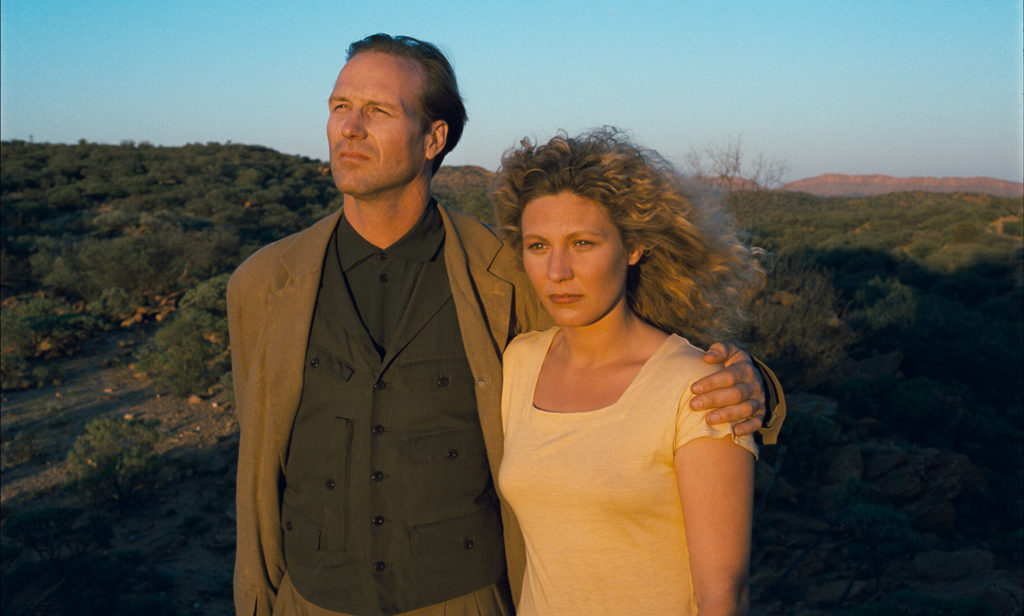
The plot, such as it is, involves Claire (Solveig Dommartin, RIP), a vivacious French woman, leaving her freewheeling life behind in order to pursue the mysterious Trevor (William Hurt) around the world. Eventually we learn that Trevor has run off with his father’s invention, a device that records what its wearer sees, and can then make those images visible to the blind. (Considering the size of the budget, you might expect the device to look less like a ViewMaster attached to a colander.) The couple travel around the globe, evading authorities, betraying one another, and committing crimes, all in an effort to record images of the world so that Hurt’s blind mother can see them before she dies. Running in the background is something about a satellite that is crashing to earth, which has the world freaked out.
It’s a fabulous cast, including the late, great Max Von Sydow and the always reliable Sam Neill. The two leads, William Hurt and Solveig Dommartin, are attractive, in their physical prime, and spend some time shirtless, but even PG-13 nudity can’t justify a nearly-five hour run time. Would anything? Well, maybe, but not for this movie. I’ve sat through some long movies, most notably the extended version of the Lord of the Rings, which I can watch without ever growing bored. Butt-sore maybe, but never bored. And the scenes which were added to the LOTR extended cuts are fan-pleasing bits from the books that were dropped as they don’t really drive the plot. I can see why they’d be left out, but as a Tolkien fan I appreciate seeing Pippin and Merry enjoying the growth effects of Treebeard’s enchanted pool. Other epics, like Doctor Zhivago, are tedious (to me anyway) but at least the story is always going somewhere. The same can’t be said for Until the End of the World.
The movie is so flawed right to its DNA that I don’t see a way to save it. Just read this disjointed tagline:
It’s 1999. The government will kill for his invention. One woman will do anything for his love. Together they share an adventure that circles the globe – And invades the mind.
WTF. Even the tagline doesn’t know what kind of movie it is, which leads me to the first on my list of the film’s many failings…
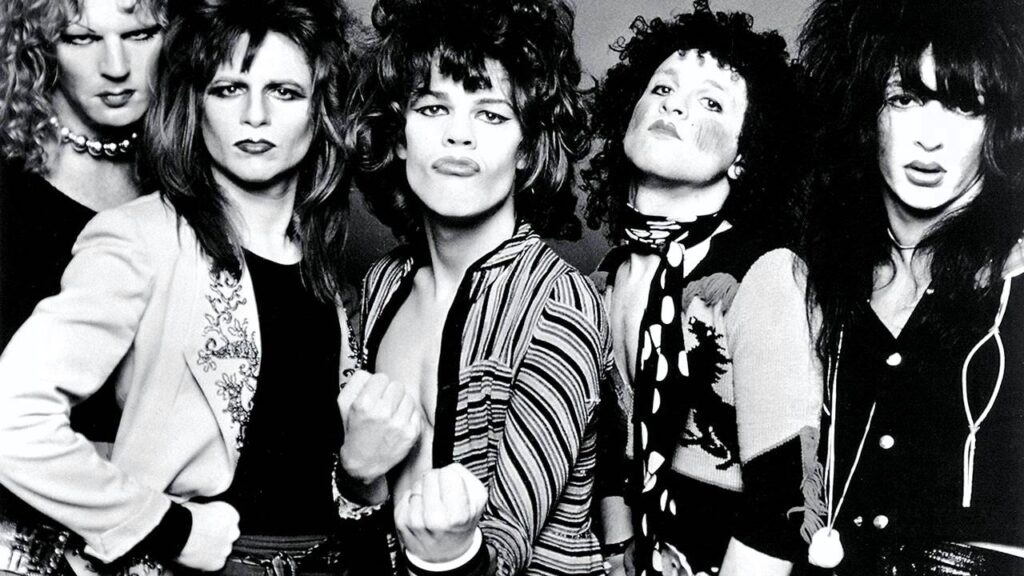
Personality Crisis: The downfall of many a film is a lack of commitment to, or understanding of, its core persona. Until the End of the World suffers from this common ailment, not knowing if it’s a travelogue, a romance, a spy thriller, a sci-fi cautionary tale, or an exercise in audience endurance. I understand that Wenders imagined it as the “ultimate road movie” but if you think of the greats, from Detour to Thelma and Louise, the travel aspect runs the length of the movie, and, in the end, the characters are transformed. That sort of happens here, but in the five hour version the road ends before the movie does, and any enjoyment that this viewer had dies a slow and protracted death in the Australian outback. Speaking of which, in an interview with Wenders that accompanied this new cut, he speaks about his original idea for the movie, which involved a scientist (Sydow) locked in a cave in Australia following a nuclear war. That actually goes a long way towards explaining the disjointed nature of the film, and why it spends so much time in Australia at the end.
Stultifying Boredom: I’m not the most patient person, but I have managed to sit through some pretty slow movies. (I’m looking at you, Solaris.) If a director is expecting their audience to sit through a movie 2-3 times longer than normal, then they’d better provide a commensurate increase in narrative. Obviously, this didn’t happen. We get slow scenes of people talking, or walking, or staring off into the distance. Later we get scene after scene after scene of fuzzy computer renderings.
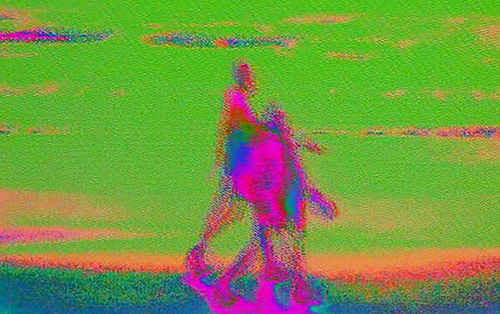
Consider the wonderful, if melancholy, Nomadland. It too is a road movie, and one with even less action than UTEOTW. The difference is that the director of Nomadland ensures that each scene tells us more and more about the characters and their world. Occasionally, the camera moves away from the nomads to take in the vistas of their beautifully spartan world. It all means something.hat’s a slow moving tale I can get behind.
Bad Sci-Fi: 8 years into the future is not that much of a stretch, making this reviewer wonder why they bothered at all. The “futuristic” elements are sparsely, nay, half-assedly presented. Has Wenders even seen a sci-fi movie? Super Nintendo level graphics on a monitor do not a vivid future make. Also, is it supposed to be a mishmash of time periods? Hurt spends half of the movie in a kind of Humphrey Bogart drag that suggests film noir, but that idea is never fully realised. When it comes to sci-fi film noir, Ridley Scott already hit a home run with Blade Runner. And if you want to see anachronism done right, look no further than Tim Burton’s first Batman, which has video calls in one scene and mid-century flashbulb cameras in the next. Or the teen horror flick It Follows, which adds disconcerting anachronisms throughout.
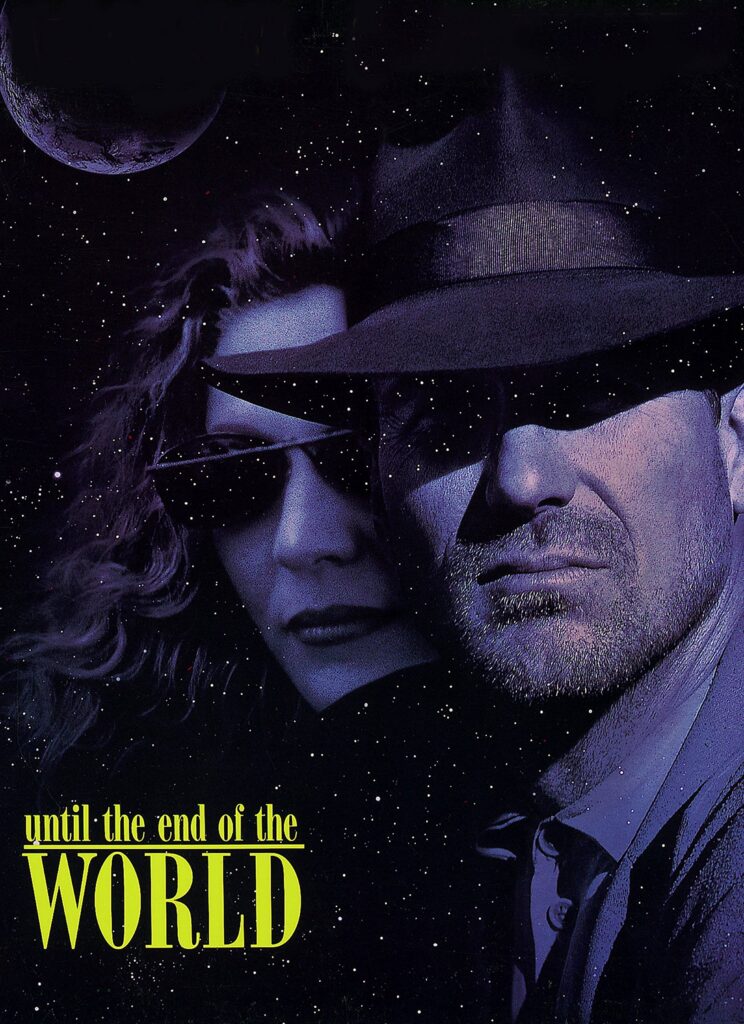
Vestigial Characters: Many people get caught up in the narrative’s wake, often due to their attraction to the female lead. When the storylines of these side characters run out of steam, the movie keeps them on board, despite having no use for them. Rüdiger Vogler’s private eye Philip Winter is added early on, but four hours later there he is up on screen, with nothing to do in the finale except be part of an interminable, multicultural jam session. WHY?????? There are at least three men in the finale who are completely taken with, but not lovers of, the female lead.
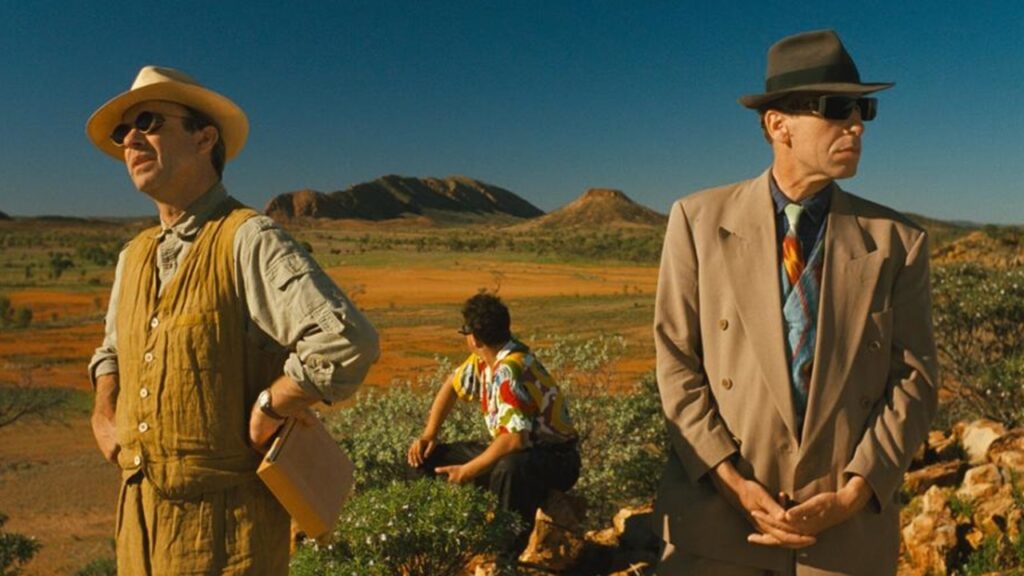
All that being said, I always appreciate someone with intense commitment to their own vision. Wenders fought for years to make this happen, cobbling together finances and taking a crew around the world- Lisbon, Berlin, Moscow, Beijing, Tokyo, San Francisco, and around Australia. He had a dream and he fought to realise it. Unfortunately, his dream stinks. If I get the opportunity, I still might check out the shortest version available, just to see what it’s like. Call me nostalgic.
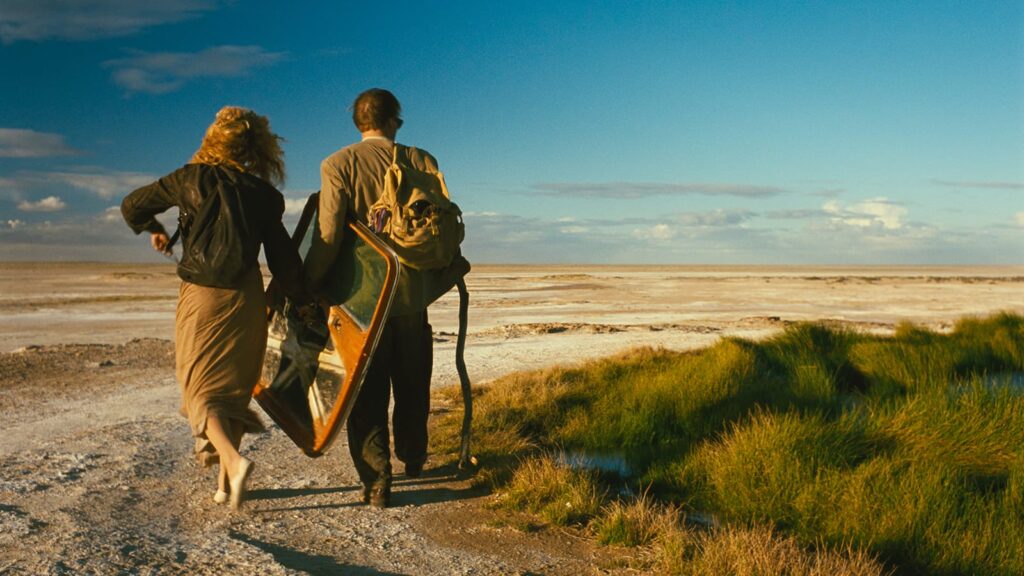
Dune and Me, Me and Dune
In 1984, I was 13 years old and in Grade 7. Was I the coolest kid in school? You bet I wasn’t. I was a comic book loving, sci-fi watching, horror movie fanatic, and all-around obsessive dork. It was a tumultuous time, to say the least.
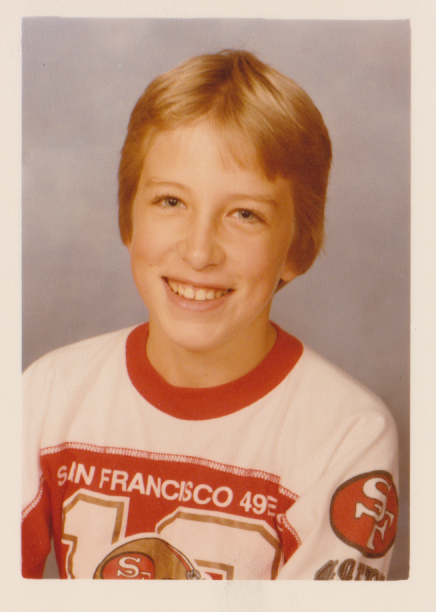
I went to a country school, about half an hour from Kingston, Ontario. One sunny day after school, my teacher packed me and a few other boys in his car to take us book shopping. No teacher in their right mind would do such a thing these days, but we were excited to go shopping, and, as hayseeds, were impressed by his vehicle, which spoke to you if you left the door down or didn’t buckle up. It was just like K.I.T.T. on Knight Rider! It even had electric window openers- commonplace today, but the stuff of science fiction at the time.
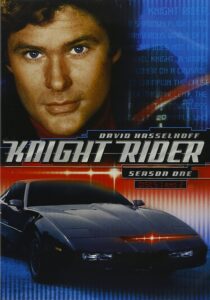
He drove us to the school resource centre where teachers could purchase discounted books and supplies. After being reprimanded for perusing a rack of comics, I picked up a copy of Frank Herbert’s Dune, in anticipation of the David Lynch film that was due out that year. I knew nothing about the book or the movie, except what I’d read in a magazine (possibly Starlog.) An epic, outer space extravaganza? I’m in! I had a very isolated life out in the country, and lived for whatever sci-fi or fantasy materials I could get my hands on. I knew nothing about David Lynch, but would grow into a fan over the years. (Twin Peaks was still six years away at this point.)
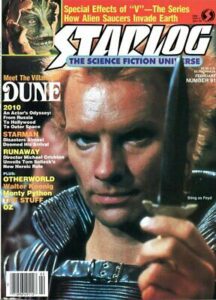
I’m a slow reader, always have been and always will be. In fact, I think I’m getting even slower over time. But even when my brain was younger and my synapses were still firing, it took me months to get through the book. (Decades later, when she reached the age of 13, my own offspring read it in a matter of weeks, just to show off. Little rapscallion.)
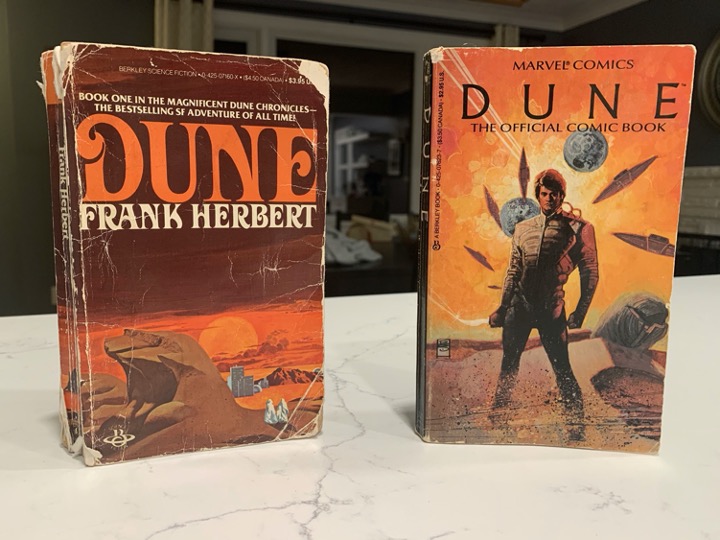
I had never read anything like it. It never occurred to me that there even *was* a 20,000 years in the future! The world was immense and alien, but also close and familiar; behind all of the unfamiliar words (I’m looking at you, Kwisatz Haderach) lay a very familiar world. An emperor ruled over a series of nobles who were growing restless. (Mediveal England.) Factions were fighting in the desert over a valuable resource. (Oil.) The indigenous population were treated as vermin by the occupying colonialists. (Basically everywhere.) And the good guys didn’t stand a chance without playing dirty. (Also basically everywhere.) This wasn’t Star Wars or Star Trek, this felt real.
Despite the epic length and strange vocabulary, I kept at it. I felt a beam of pride when my doctor saw me reading it and told me he’d given up halfway through. Aren’t I smart! Side note: I also discovered the comic book adaptation, illustrated by Bill Sinkiewicz. A lifelong appreciation of his work was born..
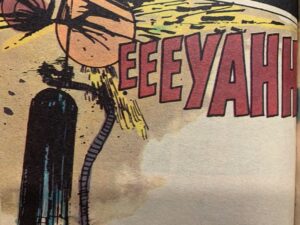
When I finished the book, I was excited to see the movie. Even at that young age, I knew that the special effects were mixed, and that the casting wasn’t always appropriate, but I liked it well enough. At times, it even came close to creating images that matched those in my own imagination, especially the Lady Jessica and her Bene Gesserit sisters. I know the film gets a bad rap, is truly laughable in places, and has been disowned by its own creator, but I stand by it for what it is.
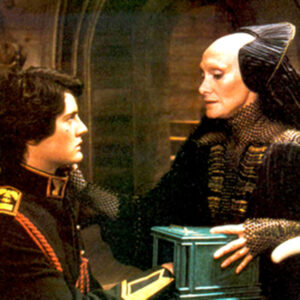
The made-for-TV series that followed was better from a technical point of view (and had some stellar actors) but was a little too slick to capture the gritty world of Dune. (Which *is* made of sand, after all.)
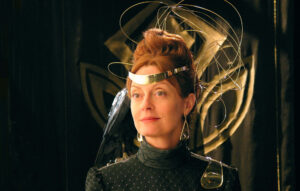
I tried to read the other Dune books, but found it hard to stay interested in their endlessly, talky narratives. It was also hard to accept that the joyful liberation of Dune at the end of the first book led to a violent, galactic jihad. I wanted my heroics a little purer than that. I still do. So I gave up, and only read the remainder of the original series when it arrived on audiobook. I even listened to some by the author’s son, who picked up the mantle of the series after his father’s death.
In university, I discovered the Dune board game. It was so far ahead of its time that I couldn’t even believe it existed. High in concept, epic in length, and discombobulating in complexity, it combined the player specialization of D&D with the tabletop combat of Risk.
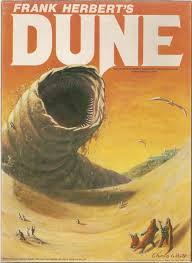
The game fell into copyright hell, apparently, but has recently been reborn in a beautiful new package, which was released *just* in time for the Denis Villeneuve film adaptation… had it not been postponed due to COVID.
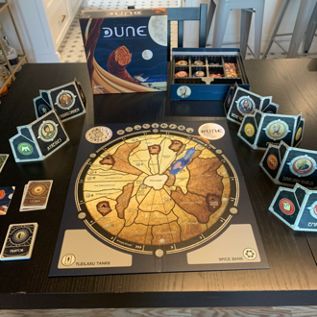
I continue to be fascinated by the world of Dune, it’s incomparably crafted world, and it’s applicability to real-life. The books are problematic in many ways- politically, socially, and even aesthetically. (The author can’t help but have the most exciting plot points happen OFF THE PAGE? Why???) So, yeah. I can’t justify everything about them. But I still admire them, and will always be there for the next adaptation…
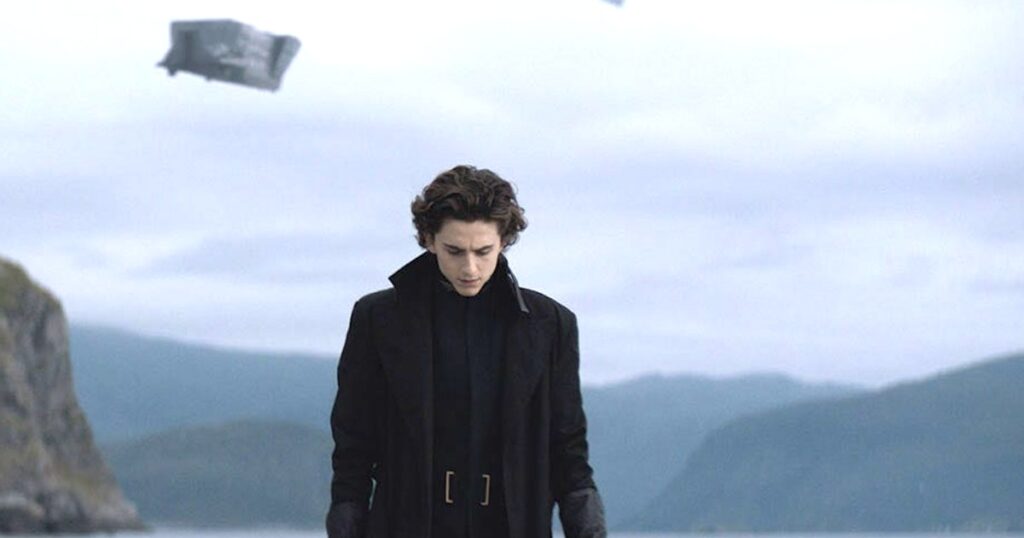
You Get What You Need
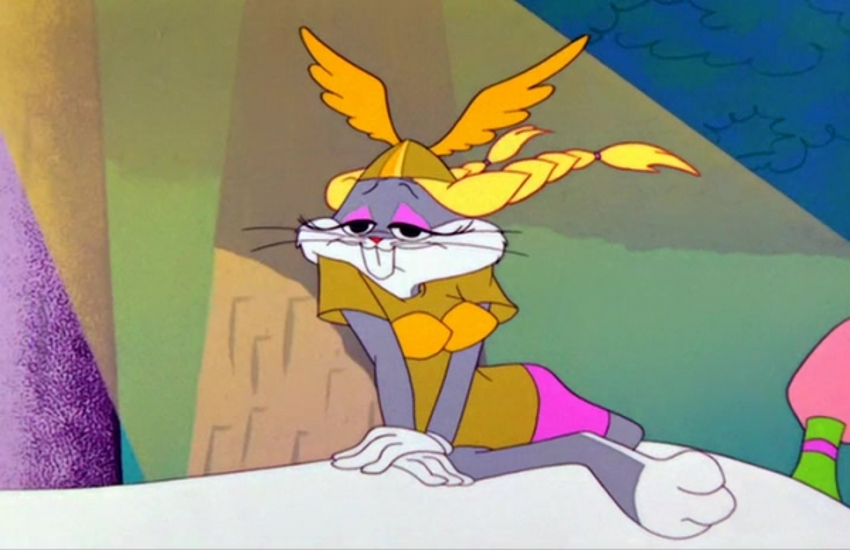
Drag has always been something that fascinated me. As a young person, I think people in drag appealed to me because they represented people who were different (read: queer) but also because they seemed both strange and confident; I had one side of the equation but not the other. They subverted gender norms and did it with a laugh. I have vague memories of seeing people in drag on television and in movies (Bugs Bunny and Benny Hill come to mind) but my first real memories are of the cover to the soundtrack for The Rocky Horror Picture Show, and Divine, who became the first drag superstar.
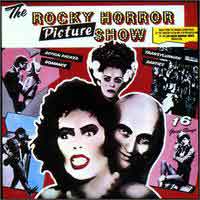
Confident and brash, Frank. N. Furter looked larger than life. It would be at least a decade before I saw the movie, but I was already fascinated. Fast forward a few decades and I had the pleasure to meet Tim Curry, debilitated by illness but still classy and charming.
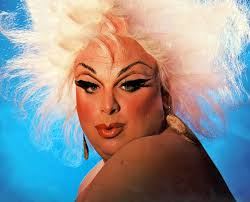
Divine on the other hand, was mesmerizing in a whole different way. He was like everyone’s debauched aunt who drank too much at a wedding: wig askew, makeup painted to high heaven, and singing with abandon.
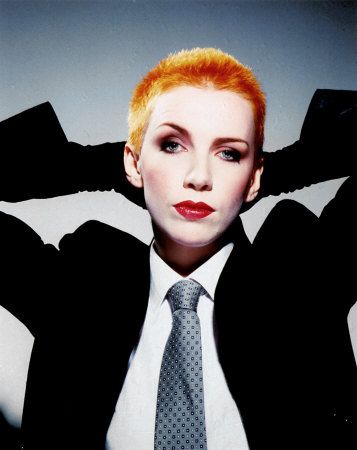
In their own ways, each of these drag artists gave me something that I needed, when I needed it. Not long after, the same can be said of Annie Lennox, who took apart what it meant to be a female pop star by combining short hair and men’s suits. She was like a reverse-gendered David Bowie, another huge inspiration for me. Her confidence, talent, and artistry continue to be an inspiration. Call me up if you’re ever in Guelph, Annie!
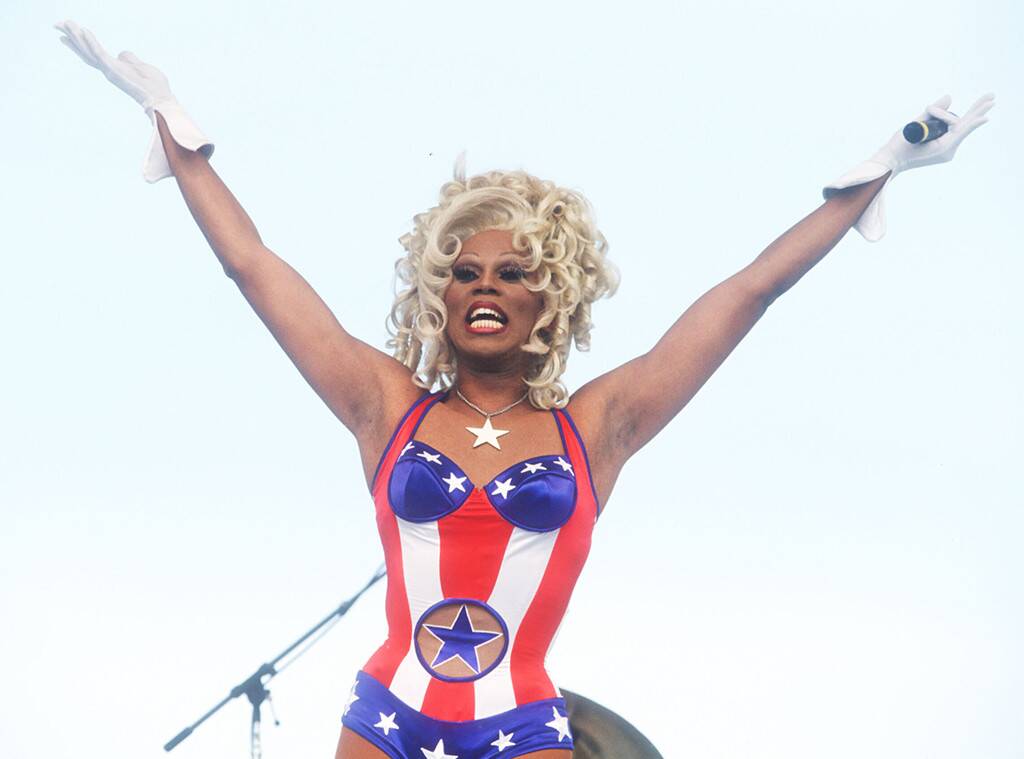
RuPaul was the first drag queen I remember who spoke politically, not just for camp or entertainment. I remember seeing her speak at a 1993 rally in Washington and thinking, “Wow! She is really something!” Little did I know then that RuPaul’s Drag Race would come to define drag for over a decade.
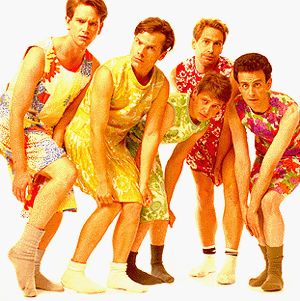
You could be forgiven for thinking that the Monty Python troupe had used up all of the humour to be found in a man in a dress, but Canada’s own Kids in the Hall brought drag humour back to the mainstream in hilarious fashion. The standout player for me was Scott Thompson (second from the right, at back) the first unabashedly gay man I remember on Canadian TV. His outlandish characters such as Buddy the socialite definitely inspired my work while I was in art school.
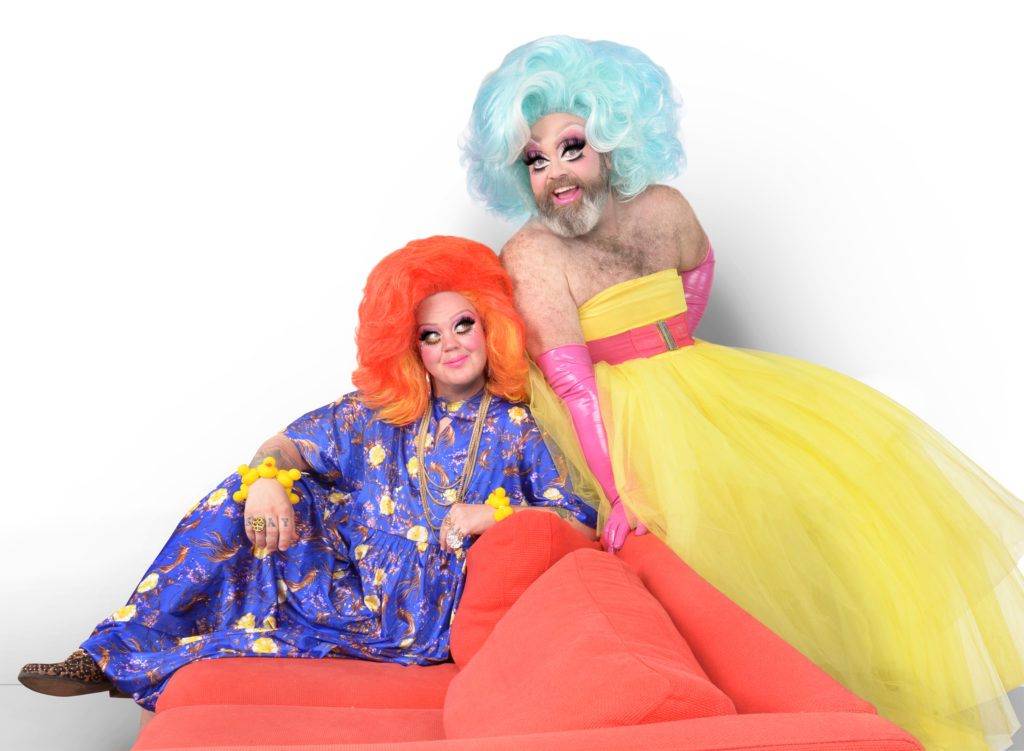
Finally, I want to speak about the Fay and Fluffy, the Toronto-based performing drag duo who have been slaying audiences both young and old for some years now. I can’t say how much it meant to me that I was able to book them at my library because, first, they put on a great show, but, also, I wanted to be able to tell the world that it’s not only ok to be different, but you can have fun doing it! We know that a little support can make a huge difference in the lives of LGBTQ+ young people, and I want to do my part to help. They were so wonderful and I can’t wait to have them back.
It seems like life has given me the drag performers I needed, when I needed them. Thanks to you all.
The Anecdotal Wonder Woman
A lot has been said about the new Wonder Woman movie (which is great, BTW) so rather than just add my voice to the hubbub, allow me to share a collection of relevant anecdotes.
A Boy in Rural Ontario Sees a Woman Kick Butt
Like many North American kids of the 1970’s, my young mind was fairly well-blown by Lynda Carter’s star turn in the campy Wonder Woman TV show of the era. This was partly due to the fact that I was obsessed with all things comic book-y and would watch anything with the barest whisper of superheroics, but the main draw was Lynda Carter as Wonder Woman. Not only was she gorgeous, statuesque, and outrageously dressed, she was also bold, intelligent, and physically adept. Wonder Woman could do anything and everything, all while wearing what amounts to a satin bathing suit. What style! What panache! Some kids wanted to be her. Others wanted to be with her. (Whatever that means when you’re seven). Others wanted both. Who can blame them?
Don’t get me wrong, the show was completely ridiculous, but Wonder Woman’s knowing smile let you know that she was in on the joke, and loving every minute.
Tears of Gratitude
A female friend texted me after seeing the movie to tell me that she had started crying during the epic No-Man’s Land scene. Not just because it’s a powerful moment (it is) but rather because she had a vision of girls all over the world being empowered by this slice of the pop culture pie. Dang, just like the end of Buffy!
Knowing how important that corny old Wonder Woman TV show was to so many, imagine what Gal Gadot’s Wonder Woman will do when millions (billions?) of girls AND boys see her kicking butt and fighting injustice on a major scale. What will they be inspired to do?
Now, not to focus on the negative but some people (let’s be polite and call them misogynistic idiots) see this as a fault. They think women and girls should NOT be encouraged and inspired. They think being inclusive is a joke, and that celebrating the accomplishments of this movie by, say, hosting women-only screenings is a terrible injustice. To them I say, I hope we have a million more movies just like this one, and you’re not invited.
A Teenage Boy Sees Things From the Other Side
My spouse (an English teacher and Wonder Woman fan) was talking to a male high school student about the Wonder Woman film, and the student said that he didn’t like it because there weren’t any men in it for the first 20 minutes or so. Wow, talk about your teachable moment. This is how half the world feels ALL THE TIME. Most women in action movies are either arm candy, victims, or, on the odd occasion that they do get to kick some butt, often objects of pleasure for male viewers.
Never underestimate the effect of seeing yourself represented in a positive way. Girls watching this may have the ability to see their own capabilities expanded. (Similarly, one reason I wrote Switch was so that bi kids could feel validated and encouraged.) But the opposite is also true; a lack of representation can have a detrimental effect, feeding a sense of otherness, or unworthiness. Where that leads you can guess.
What Women Want (in action movies)
Part of the success of the film comes from the inherently female perspective of the production team, including the director, Patty Jenkins, who made the excellent and disturbing film Monster. In making Wonder Woman, Ms. Jenkins made decisions that a male director might not have even considered, such as limiting the number of columns in the otherwise classically-inspired architecture of all-female Themyscira. (You don’t have to be Freud to figure out why.) And when asked about Wonder Woman’s costume she said, “as a woman, [I] want Wonder Woman to be hot as hell, fight badass, and look great at the same time—the same way men want Superman to have huge pecs and an impractically big body. That makes them feel like the hero they want to be. And my hero, in my head, has really long legs.” No apologies!
Wonder Woman Crosses Generational Lines
Although unfortunately separated from my family in the theatre, I was seated with a friend, and had one of my favourite spots: back corner, top row. (Due to the gap between the arm of the chair and the wall, you have a place to store your crap. Plus, there’s no one in front of you, no one behind, and you have a clear path to the exit.) When the movie was over, I noticed a little girl of maybe six with an older woman of perhaps sixty. I’m going to go out on a limb here and say that they were a granddaughter and grandmother. When the movie was over, the little girl stood and hugged her grandmother with such love and enthusiasm I couldn’t help but appreciate what this movie can do. I’m not going so far as to say that it’s breeding a new generation of righteous Amazonians, but one can dream.
P.S.
I know that this film isn’t without its criticisms, some valid, others not. But it’s still an amazing achievement. No one work has to do everything. We can appreciate the bits that speak to us, and recognize what it took to get that far. As my friend from the second anecdote said, “You know, nothing about making this movie was easy.” I can only imagine the battles behind the scenes.
P.P.S
I thought Gal Gadot was phenomenal, both as the defiant demigoddess Wonder Woman, and also as the sensitive, regal, and naive Diana. (It doesn’t hurt that she’s also incredibly beautiful.) I haven’t seen something like that in a superhero movie since a very young me fell in love with Christopher Reeve as Superman.
Faint Glimmers of Civilization
I have a complex relationship with Hallowe’en. I love the spookiness, but I hate the commercialization. I love the costumes, but I hate the way they often reinforce stereotypes. And whatever happened to the apostrophe? I still use it out of sheer determination.
Not that I’m recommending it, but as a kid growing up in a rural area, Hallowe’en meant pitch black dirt roads and indistinct costumes thrown together in the hour before trick or treating began. As I got older, it also meant late-night pranks and subsequent escapes through moonlit cornfields.
With that in mind, I decided to celebrate Hallowe’en by throwing a party with a Wes Anderson theme. If you haven’t seen his films, do so. (That’s an order.) While The Grand Budapest Hotel isn’t my favourite of his films, I certainly adored the character of Gustave. I could go into the many reasons why I feel such an affinity for him, but I’ll let his words speak for me: “There are still faint glimmers of civilization left in this barbaric slaughterhouse that was once known as humanity.”
One for the books
Eden Mills was great; I got to meet some fabulous authors and hear them read their own works, which is always a blast. The YA area was very well-attended and the Bookshelf sold out of my books- I even gave away my reading copy!
I’m working on a short story collection. One of the short stories is a loving satire of / homage to dystopian romances and the enthusiastic fanfic they inspire, a case where imitation truly is the most sincere form of flattery. I wasn’t sure how it would go over but my worries (and ego) were put to rest by the fantastic response the story received from the crowd. It’s called Heroth Nefer Die. It helps to stick your tongue out while you say it.
Thanks to Eden Mills and my presenter (far right in the group photo below).
All photos by Helen Kubiw.
Full Circle at Eden Mills Writers’ Festival
So… way back when I used to volunteer as a ‘handler’ for children’s authors at the always-amazing Eden Mills Writers’ Festival. It was a fun gig and I got to meet lots of people and also help support kids and the kids’ lit community. Now, I’ll be one of the authors. It’s a real honour to be asked and I’m so looking forward to it. As you may now from my earlier postings, 2016 has been an annus horribilis for me. I relish any opportunity (such as EMWF) to help make it an annus mirabilis. Hope to see you there!
P.S. Kudos to the designer of the poster, it looks fab
